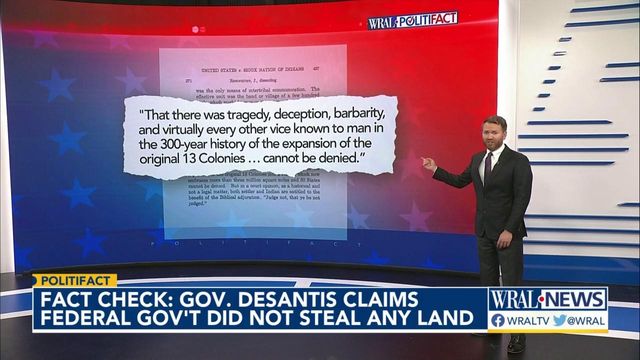Fact check: DeSantis says U.S. wasn't built on stolen land
In the only gubernatorial debate before the Nov. 8 election, Gov. Ron DeSantis said: "You have people that are teaching -- and actually his running mate has said this in the past -- that teaching the United States was built on stolen land. That is inappropriate for our schools; it's not true." PolitiFact checks his claim.
Posted — Updated"You have people that are teaching — and actually his running mate has said this in the past — that teaching the United States was built on stolen land," DeSantis said Oct. 24. "That is inappropriate for our schools; it's not true."
We wondered what DeSantis was referring to and whether he was right in his assessment of whether the U.S. was built on "stolen land."
The Facebook post included an image of a sign that read: "No one is illegal on stolen land." Hernández-Mats did not respond to specific questions about the image. The post was shared at a time when U.S. immigration policies were dominating the news.
We reached out to historians of Native and non-Native descent. All of them said it is well documented that the U.S. acquired Native American land through dubious treaties and, at times, forcefully confiscated ancestral territories to bolster the country's expansion.
"As a general statement, yes, the United States stole land from Native Americans," said Philip Deloria, a Native American history professor at Harvard University.
Sometimes the U.S. and Native American tribes struck treaties that defined boundaries and determined land sale prices and forms of compensation. Other times, tribes signed land-ceding agreements under duress.
Deloria said the U.S. often placed compensation for these deals in U.S.-controlled trust funds or promised payment over a number of years, but then failed to follow through.
The Sioux Agreement of 1877 is an example of the U.S. acquiring land from Native Americans through fraudulent practices and treaty violations.
The U.S. then moved to negotiate with the Sioux to acquire the land. The deal fell through, which led to a war and hundreds of deaths. The tribe later surrendered and signed a treaty that ceded the Black Hills to the U.S.
The U.S. Court of Federal Claims ruled in 1975 that the Sioux are entitled to damages of around $17 million for this land seizure. The court remarked: "A more ripe and rank case of dishonorable dealings will never, in all probability, be found in our history."
In a dissenting opinion, Chief Justice William Rehnquist wrote, "There was tragedy, deception, barbarity, and virtually every other vice known to man in the 300-year history of the expansion of the original 13 Colonies into a Nation which now embraces more than three million square miles."
The U.S. sometimes bought Native land from European countries, like France, and claimed ownership even though "France did not treaty with the many tribes who lived upon that land," said Randy Woodley, director of intercultural and indigenous studies at George Fox University.
"The post-Civil War period is full of people being compressed, contained, and confined onto small reservations within their territory, in order to accommodate non-Native settlement," Deloria told PolitiFact.
"It is historically inaccurate to say the land was not stolen from Native Americans," Woodley said.
PolitiFact ruling
DeSantis said it's not true that "the United States was built on stolen land."
Historians of Native and non-Native descent said DeSantis' characterization is wrong. It's well-documented that the U.S. repeatedly made treaties with Native Americans and then violated them using force and other means to accommodate non-Native settlement. Courts, including the U.S. Supreme Court, have time and again affirmed that as fact.
Government-endorsed actions to remove Native Americans from their ancestral lands included the 1830 passage of a federal law that led to war and resulted in thousands of Native deaths and more than 3,000 Seminoles being removed from Florida.
DeSantis' claim is wildly historically inaccurate. We rate it Pants on Fire!
Related Topics
Copyright 2024 Politifact. All rights reserved.





